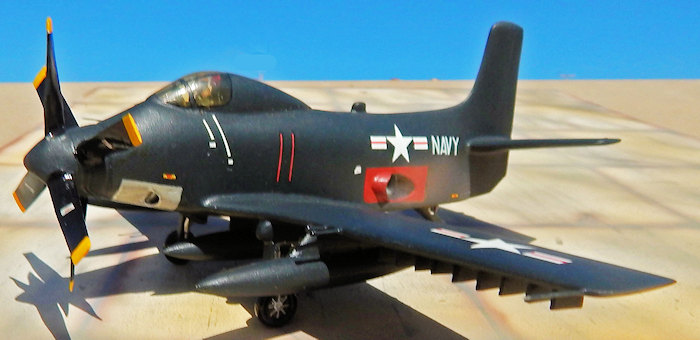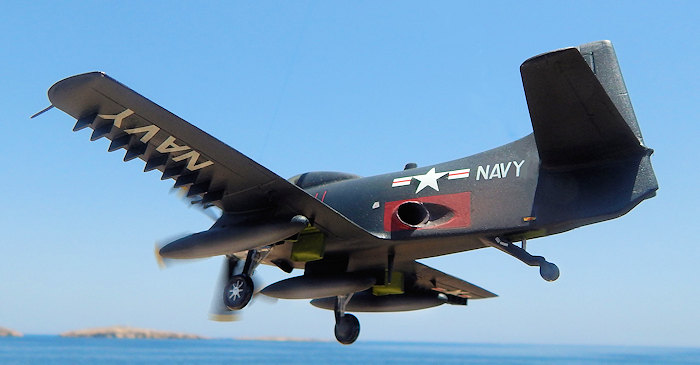
| KIT #: | |
| PRICE: | |
| DECALS: | None included |
| REVIEWER: | Carmel J. Attard |
| NOTES: | Vacuform with metal parts |

| HISTORY |
Development of the Douglas
Skyshark was originally begun with the idea of incorporating as many components
as possible from the existing Skyraider shipboard attack bomber. It became
apparent that the ever-changing strength, stability and equipment specifications
effected initially every component of the design while the area and span of the
Skyraider‘s wing were retained for the thinner section wing of the Skyshark. Few
other features retained any similarity when the first of two XA2D-1 Skyshark
prototypes (Bu Aer No 122988) flew on May 26th
1950. The XA2D-1 was powered by an Allison XT40-A-2 twin turboprop engines
mounted side by side and driving a co-axial contra rotating airscrews through a
common gear box, offered 5,100 hp plus 830 lb residual thrust fo r takeoff;
weighing 12,944 lb empty and 16,224 and 21,764 lb in normal and maximum loaded
condition.
r takeoff;
weighing 12,944 lb empty and 16,224 and 21,764 lb in normal and maximum loaded
condition.
The XA2D-1 attained 450mph at sea level and 492mph at 27,000 ft in clean conditions and 442mph with a 2000 lb external bomb load. From the outset of flight trials difficulties were experienced with the gearing and contra-rotating propellers.
The second XA2D-1 (Bu Aer No 122989) was re-engined with a semi-production version of the power plant the XT40-A-6 but continued delays in the programme resulted from power plant failures, and the production orders were cut back to ten A2D-1s, these subsequently being used primarily as power plant test beds.
The Rareplanes scale model is that of Douglas A2D-1 Skyshark (Bu Aer 125480). This was the first production-style aircraft to fly with Douglas test pilot George Jensen at the controls on 10 June 1954. He ejected from a flight on 5 August 1954 because of gearbox failure which caused the aircraft to crash. The production A2D-1 had slight differences from the more well known XA2D-1, with a rounded cockpit canopy, redesigned armament racks and jet afflux.
It was a brave attempt to stretch the famous Skyraider design into the jet-propulsion era. The A2D Skyshark with its troublesome turbine-engine vibration problems did not fulfil expectations. The project was cancelled and the design overtaken by the highly-successful A4D Skyhawk.
| THE KIT |
 The early 50s has always been a period that holds
much fascination for many modelers and it was Rareplanes that came out to
release the unusual subject, an aircraft which never actually saw operational
service. The Rareplanes model of the Skyshark represented an advance over
earlier vac form kits where white metal parts were now issued for intricate
parts like the undercarriage legs and complex contra-rotating propeller blades
feature. These rendered the kit not overly difficult to assemble and it makes
for an interesting if not particularly attractive finished model.
The early 50s has always been a period that holds
much fascination for many modelers and it was Rareplanes that came out to
release the unusual subject, an aircraft which never actually saw operational
service. The Rareplanes model of the Skyshark represented an advance over
earlier vac form kits where white metal parts were now issued for intricate
parts like the undercarriage legs and complex contra-rotating propeller blades
feature. These rendered the kit not overly difficult to assemble and it makes
for an interesting if not particularly attractive finished model.
The kit comes on the usual sturdy Rareplanes card box with the white styrene sheet containing the kit vac parts. In a separate bag were the white metal oleo legs and propeller parts. There is also the vac canopy in clear styrene. Four-page instructions contain accurate scale plans, a side view of a production Skyshark, scrap line views drawings of the cockpit area and correct undercarriage arrangement when lowered. An exploded parts view indicated the general parts where they should go as well as description of the method how to go about building the model.
| CONSTRUCTION |
 A sharp pointed blade is used to score around each
molded part before bending and breaking it away from the carrier sheet. Molding
pips removed with a sharp blade. Centreline of joints was then sanded on medium
grade sanding paper until the correct size is achieved. A thin flake of plastic
will indicate when the correct size is achieved.
A sharp pointed blade is used to score around each
molded part before bending and breaking it away from the carrier sheet. Molding
pips removed with a sharp blade. Centreline of joints was then sanded on medium
grade sanding paper until the correct size is achieved. A thin flake of plastic
will indicate when the correct size is achieved.
The cockpit bath tub provided was then shaped by filing, pilot seat added and an instrument panel glued to the forward part of the tub. Instruments and interior were painted, tabs added to act as guides before joining the fuselage parts together.
A wing spar was cut from spare plastic and a slot was cut at the wing root position, one on either side of the fuselage through which the spar is inserted. These provided a strong joint when the wings are inserted. This also provided the correct wing dihedral.
 The wings were treated in same fashion like the
fuselage during cutting and sanding, the undercarriage bays were cut, sanded
smooth and were glued with super glue to fuselage. Drop tanks, tail planes and
wheel well doors were also cut and added to the kit. The white metal prop
arrangement was a sub assembly and also required fine cleaning using a smooth
file to produce the desired edges. The undercarriage legs also required some
cleaning from the little flush present. These were glued to their correct
location using super glue.
The wings were treated in same fashion like the
fuselage during cutting and sanding, the undercarriage bays were cut, sanded
smooth and were glued with super glue to fuselage. Drop tanks, tail planes and
wheel well doors were also cut and added to the kit. The white metal prop
arrangement was a sub assembly and also required fine cleaning using a smooth
file to produce the desired edges. The undercarriage legs also required some
cleaning from the little flush present. These were glued to their correct
location using super glue.
It is a matter of experience with method used on vac form kits and the sequence is practically similar with every case apart from the fact that with larger kits more robust reinforcement to the interior using bulkheads positioned at intermittent stations would be required.
A pre-painted crew figure was added to the cockpit seat and the carefully trimmed canopy fixed in place. Detail to tail wheel and engine outlet was added at this stage.
| COLORS & MARKINGS |
 The model was sanded from excess filler at wing roots,
canopy masked and was given an overall coat of Compucolor brand, sea blue. I
added Super scale white star and red bars insignia decals to upper port/lower
starboard outer wings and on both sides of rear fuselage. Navy block capitals
decals in white on fuselage and under port wing. Step guide lines and a few
small instructionslettering in white Aluminium panel added under nose and red
oblong panels around jet efflux and red double stripes on fuselage sides.
Propeller blades were gloss black with yellow tips and white lettering. White
Aeroproducts Trademark added to prop blades.
The model was sanded from excess filler at wing roots,
canopy masked and was given an overall coat of Compucolor brand, sea blue. I
added Super scale white star and red bars insignia decals to upper port/lower
starboard outer wings and on both sides of rear fuselage. Navy block capitals
decals in white on fuselage and under port wing. Step guide lines and a few
small instructionslettering in white Aluminium panel added under nose and red
oblong panels around jet efflux and red double stripes on fuselage sides.
Propeller blades were gloss black with yellow tips and white lettering. White
Aeroproducts Trademark added to prop blades.
| CONCLUSIONS |
 In view of its unique shape and type of propulsion
fitted on the Skyshark, this has been an interesting addition to my
US Navy variety aircraft types of the post war era.
In view of its unique shape and type of propulsion
fitted on the Skyshark, this has been an interesting addition to my
US Navy variety aircraft types of the post war era.
It was a straightforward enjoyable build and highly recommended to those keen on all Navy types particularly those of the early 50s era.
25 July 2016
Copyright ModelingMadness.com
If you would like your product reviewed fairly and fairly quickly, please contact the editor or see other details in the Note to Contributors.